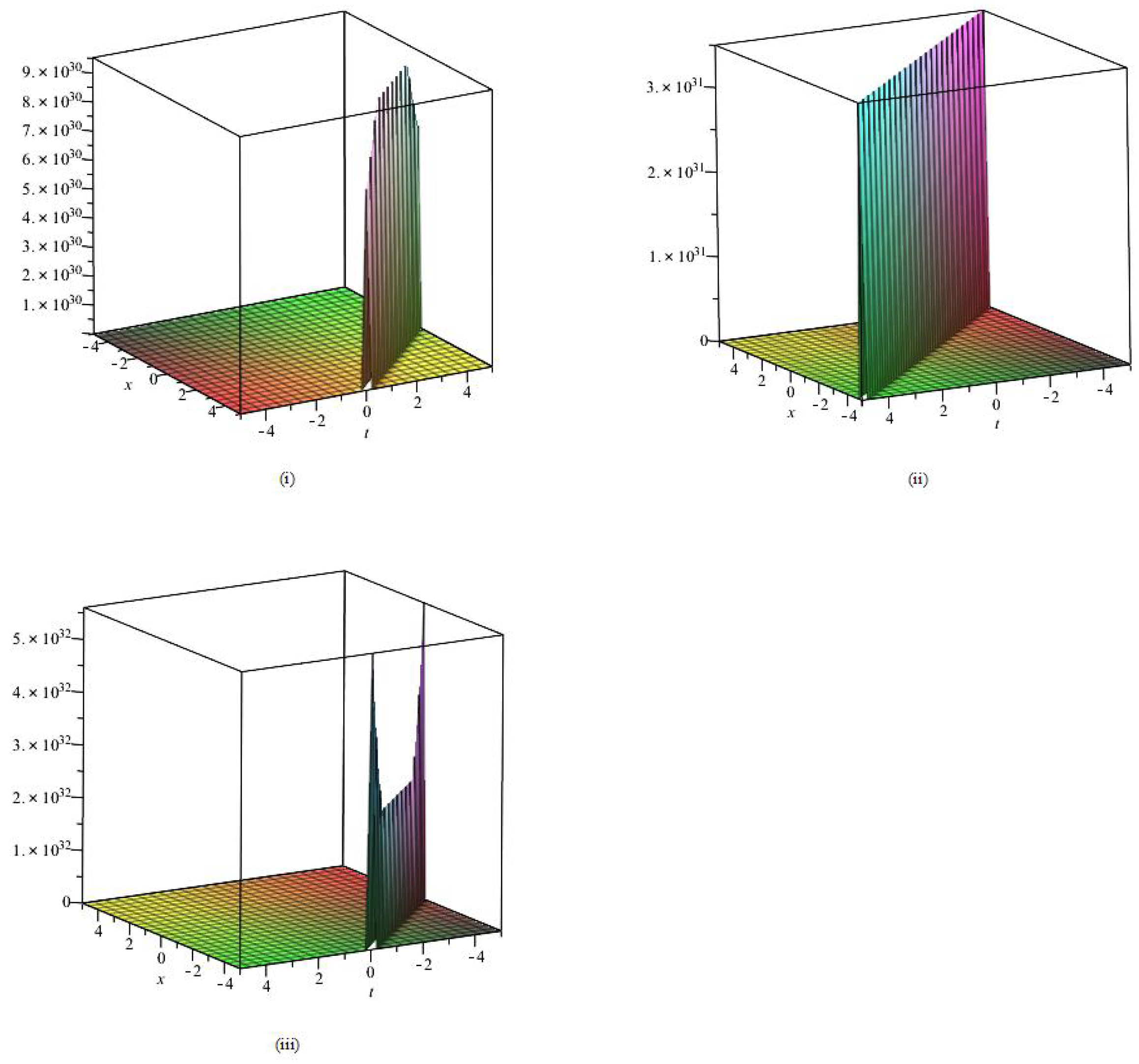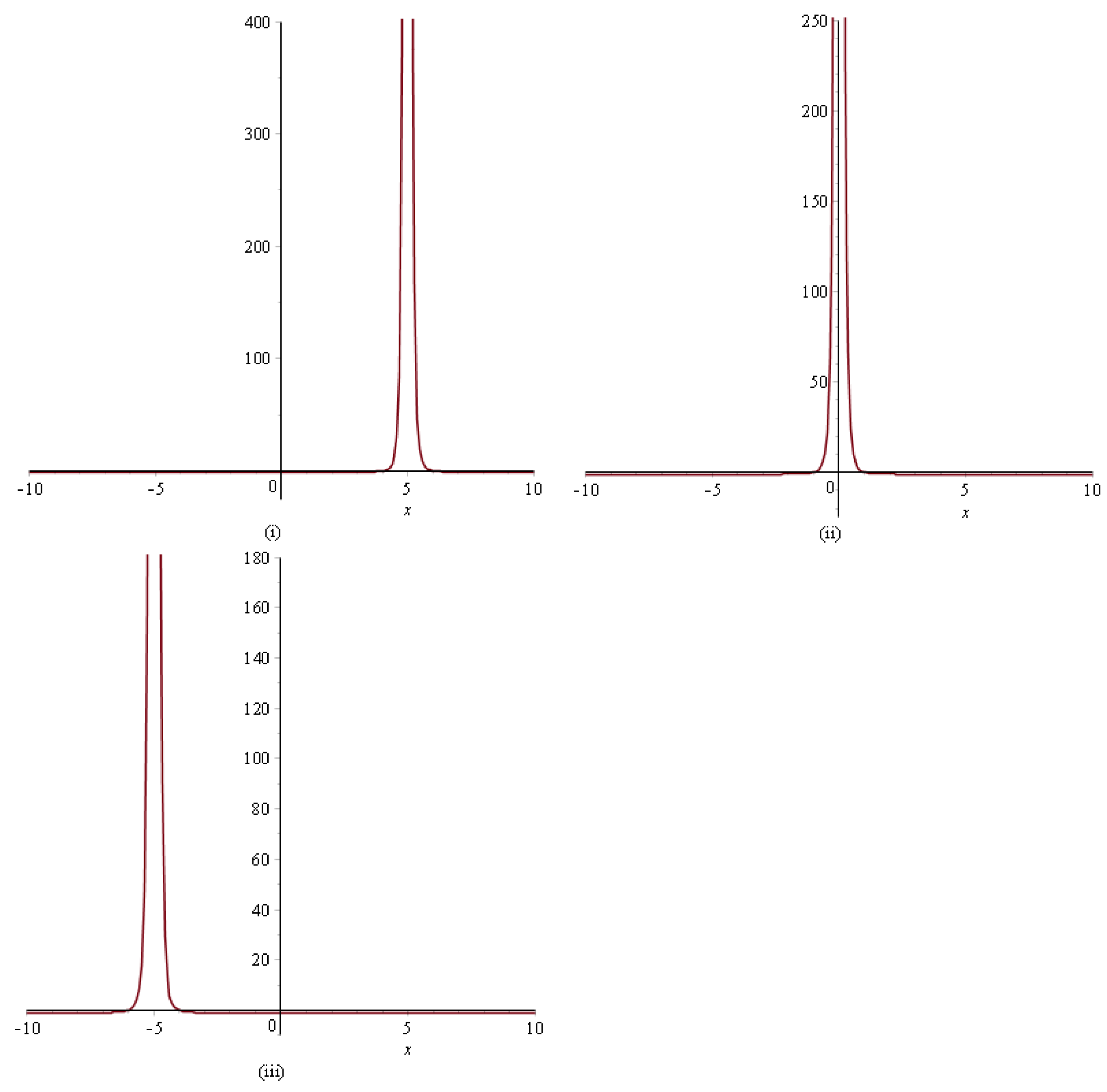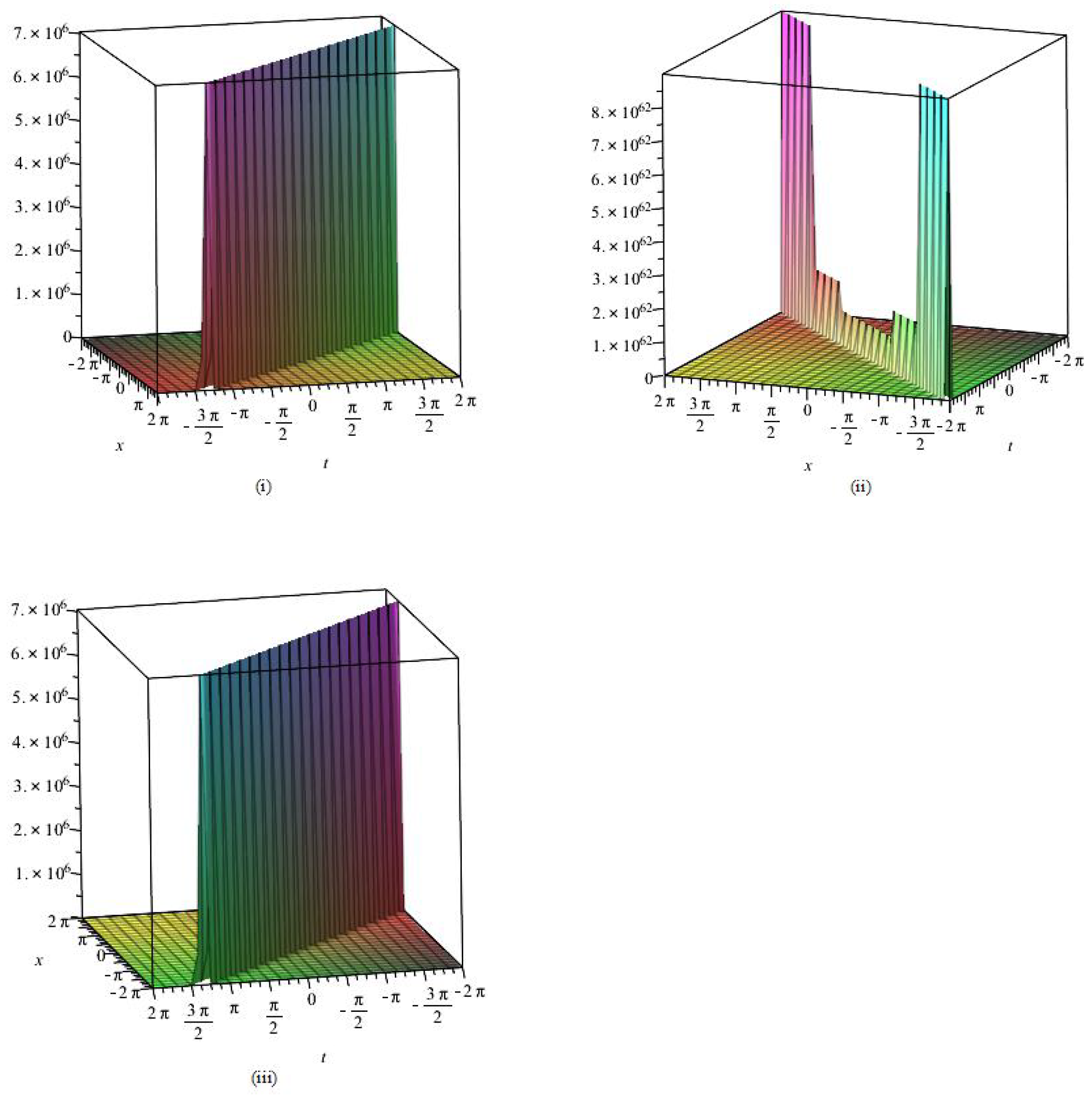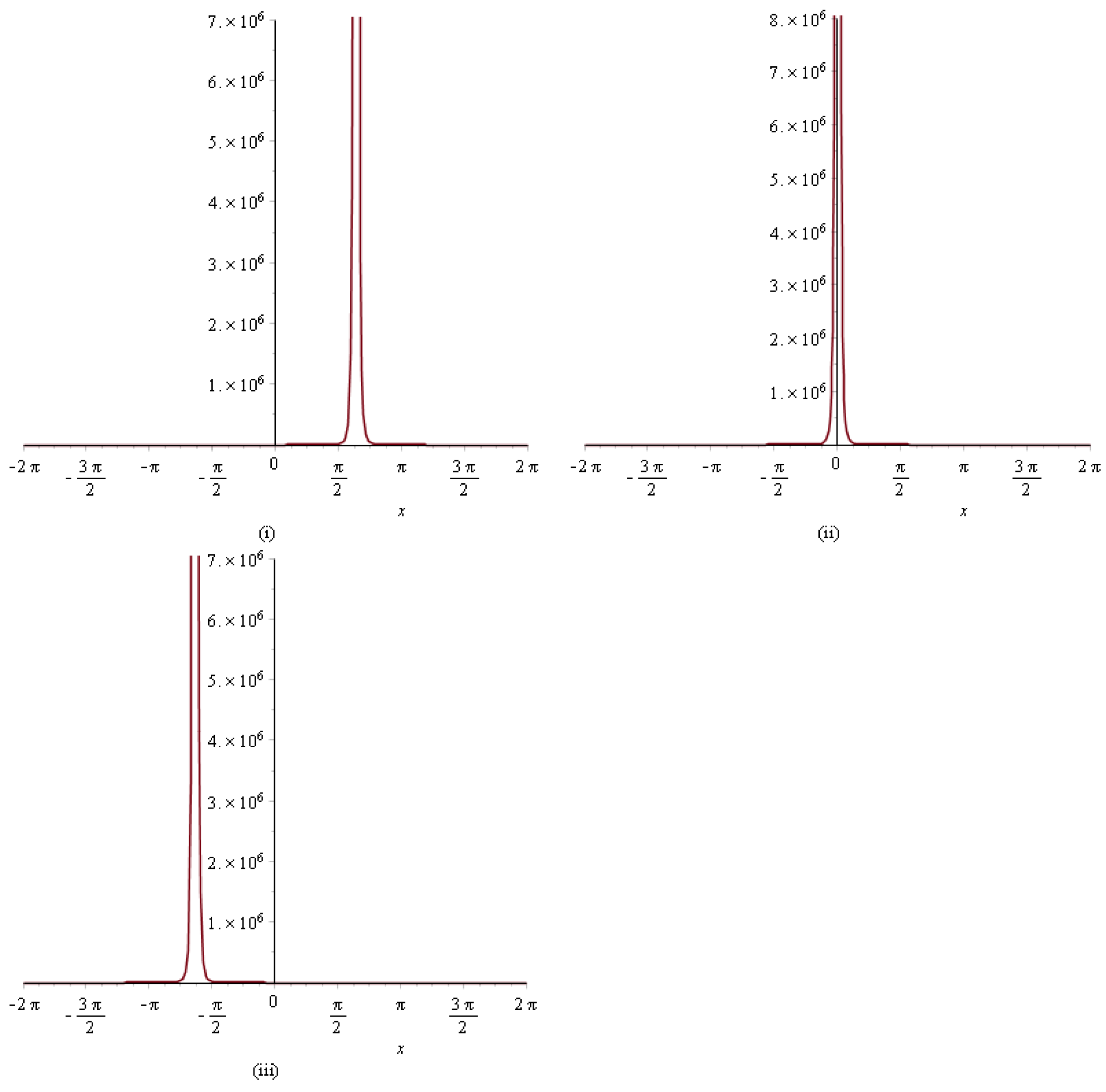All Traveling Wave Exact Solutions of the Kawahara Equation Using the Complex Method
Abstract
1. Introduction and Main Results
2. Preliminary Lemmas and the Complex Method
- Substituting the transform into a given PDE yields a nonlinear ODE: Equation (4) here.
- Insert (18) into Equation (4) here to determine that weak condition holds.
- By (22)–(24), we obtain all meromorphic solutions of Equation (4) here with pole at .
- Get all meromorphic solutions by Lemmas 1 and 2.
- Inserting the inverse transform into , we obtain all exact solutions of the given partial differential equation.
3. Proof of Theorem 1
4. Computer Simulations
- By applying the complex method, we are able to achieve the rational solution of Equation (4). Figure 1 describes the 3D graphs of solution for , , and within the interval . Figure 2 shows the 2D graphs of solution for , , and within the interval when . It could be observed that they have one generation pole, which is shown by Figure 1 and Figure 2.
5. Conclusions
Author Contributions
Funding
Institutional Review Board Statement
Informed Consent Statement
Data Availability Statement
Acknowledgments
Conflicts of Interest
Appendix A
- The system of Equations (1):
- The system of Equations (2):
- The system of Equations (3):
References
- Kawahara, T. Oscillatory solitary waves in dispersive media. J. Phys. Soc. Jpn. 1972, 33, 260–264. [Google Scholar] [CrossRef]
- Wazwaz, A.M. New solitary wave solutions to the Kuramoto-Sivashinsky and the Kawahara equations. Appl. Math. Comput. 2006, 182, 1642–1650. [Google Scholar] [CrossRef]
- Yusufoǧlu, E.; Bekir, A.; Alp, M. Periodic and solitary wave solutions of Kawahara and modified Kawahara equations by using sine-cosine method. Chaos. Soliton. Fract. 2008, 37, 1193–1197. [Google Scholar] [CrossRef]
- Kaya, D.; Al-Khaled, K. A numerical comparison of a Kawahara equation. Phys. Lett. A. 2007, 363, 433–439. [Google Scholar] [CrossRef]
- Wazwaz, A.M. Partial Differential Equations and Solitary Waves Theory; Higher Education Press: Beijing, China, 2009. [Google Scholar]
- Jang, B. New exact travelling wave solutions of Kawahara type equations. Nonlinear Anal. 2009, 70, 510–515. [Google Scholar] [CrossRef]
- Kudryashov, N.A. A note on new exact solutions for the Kawahara equation using exp-function method. J. Comput. Appl. Math. 2010, 234, 3511–3512. [Google Scholar] [CrossRef]
- Kaur, L.; Gupta, R.K. Kawahara equation and modified Kawahara equation with time dependent coefficients: Symmetry analysis and generalized (G’/G)- expansion method. Math. Methods Appl. Sci. 2012, 36, 584–600. [Google Scholar] [CrossRef]
- Pinar, Z.; Öziş, Z.T. The periodic solutions to Kawahara equation by means of the auxiliary equation with a sixth-degree nonlinear term. J. Math. 2013, 2013, 106349. [Google Scholar] [CrossRef]
- Mahmood, B.A.; Yousif, M.A. A novel analytical solution for the modified Kawahara equation using the residual power series method. Nonlinear Dyn. 2017, 89, 1233–1238. [Google Scholar] [CrossRef]
- El-Tantawy, S.A.; Salas, A.H.; Alharthi, M.R. Novel analytical cnoidal and solitary wave solutions of the extended Kawahara equation. Chaos. Soliton. Fract. 2021, 147, 110965. [Google Scholar] [CrossRef]
- Ghanbari, B.; Kumar, S.; Niwas, M.; Baleanu, D. The life symmetry analysis and exact Jacobi elliptic solutions for the Kawahara-KDV type equations. Results. Phys. 2021, 23, 104006. [Google Scholar] [CrossRef]
- Dascioǧlu, A.; Cuiha, S. Unal New exact solutions for the space-time fractional Kawahara equation. Appl. Math. Model. 2021, 89, 952–965. [Google Scholar] [CrossRef]
- Demina, M.V.; Kudryashov, N.A. From Laurent series to exact meromorphic solutions: The Kawahara equation. Phys. Lett. A. 2010, 374, 4023–4029. [Google Scholar] [CrossRef]
- Wazwaz, A.M. Compacton solutions of the Kawahara-type nonlinear dispersive equation. Appl. Math. Comput. 2003, 145, 133–150. [Google Scholar] [CrossRef]
- Khan, Y. A new necessary condition of soliton solutions for Kawahara equation arising in physics. Optik 2018, 155, 273–275. [Google Scholar] [CrossRef]
- Biswas, A. Solitary wave solution for the generalized Kawahara equation. Appl. Math. Lett. 2009, 22, 208–210. [Google Scholar] [CrossRef]
- Khan, K.; Akbar, M. The exp(-ϕ(ξ))-expansion method for finding traveling wave solutions of Vakhnenko-Parkes equation. Int. J. Dyn. Syst. Differ. Equ. 2014, 5, 72–83. [Google Scholar]
- Khan, K.; Akbar, M.; Koppelaar, H. Study of coupled nonlinear partial differential equations for finding exact analytical solutions. R. Soc. Open Sci. 2015, 2, 140406. [Google Scholar] [CrossRef]
- Jafari, H.; Kadkhoda, N.; Baleanu, D. Fractional Lie group method of the time-fractional Boussinesq equation. Nonlinear Dyn. 2015, 81, 1569–1574. [Google Scholar] [CrossRef]
- Jafari, H.; Kadkhoda, N.; Azadi, M.; Yaghoubi, M. Group classification of the time-fractional Kaup-Kupershmidt equation. Sci. Iran. 2017, 24, 302–307. [Google Scholar] [CrossRef][Green Version]
- Sahoo, S.; Ray, S. Solitary wave solutions for time fractional third order modified kdv equation using two reliable techniques G’/G-expansion method and improved G’/G-expansion method. Phys. Lett. A 2010, 374, 4023–4029. [Google Scholar] [CrossRef]
- Özkan, E.M.; Özkan, A. The soliton solutions for some nonlinear fractional differential equations with Beta-derivative. Axioms 2021, 10, 203. [Google Scholar] [CrossRef]
- Wang, X.F.; Cheng, H. Solitary wave solution and a linear mass-conservative difference scheme for the generalized Korteweg-de Vries Kawahara equation. Comput. Appl. Math. 2021, 40, 273. [Google Scholar] [CrossRef]
- Rehman, S.U.; Ahmad, F.; Kouser, S.; Pervaiz, A. Numerical approximation of modified Kawahara equation using Kernel smoothing method. Math. Comput. Simul. 2022, 194, 169–184. [Google Scholar]
- El-Tantawy, S.A.; Salas, A.H.; Alyousef, H.A.; Alharthi, M.R. Novel exact and approximate solutions to the family of the forced damped Kawahara equation and modeling strong nonlinear waves in a plasma. Chin. J. Phys. 2022, 77, 2454–2471. [Google Scholar] [CrossRef]
- Yuan, W.J.; Li, Y.Z.; Lin, J.M. Meromorphic solutions of an auxiliary ordinary differential equation using complex method. Math. Method Appl. Sci. 2013, 36, 1776–1782. [Google Scholar] [CrossRef]
- Yuan, W.J.; Wu, Y.H.; Chen, Q.H.; Huang, Y. All meromorphic solutions for two forms of odd order algebraic differential eqyations and its applications. Appl. Math. Comput. 2014, 240, 240–251. [Google Scholar]
- Conte, R. The Painlevé approach to nonlinear ordinary differential equations. In The Painlev Property, One Century Later, CRM Series in Mathematical Physics; Conte, R., Ed.; Springer: New York, NY, USA, 1999; pp. 77–180. [Google Scholar]
- Yuan, W.J.; Huang, Y.; Shang, Y.D. All travelling wave exact solutions of two nonlinear physical models. Appl. Math. Comput. 2013, 219, 6212–6223. [Google Scholar]
- Yuan, W.J.; Shang, Y.D.; Huang, Y.; Wang, H. The representation of meromorphic solutions of certain ordinary differential equations and its applications. Sci. Sin. Math. 2013, 43, 563–575. [Google Scholar]
- Yuan, W.J.; Meng, F.N.; Huang, Y.; Wu, Y.H. All traveling wave exact solutions of the variant Boussinesq equations. Appl. Math. Comput. 2015, 268, 865–872. [Google Scholar] [CrossRef]
- Lang, S. Elliptic Functions, 2nd ed.; Springer: New York, NY, USA, 1987. [Google Scholar]
- Conte, R.; Musette, M. Elliptic general analytic solutions. Stud. Appl. Math. 2009, 123, 63–81. [Google Scholar] [CrossRef]
- Gu, Y.Y.; Wu, C.F.; Yuan, W.J. Characterizations of all real solutions for the KdV equation and . Appl. Math. Lett. 2020, 107, 106446. [Google Scholar]




Publisher’s Note: MDPI stays neutral with regard to jurisdictional claims in published maps and institutional affiliations. |
© 2022 by the authors. Licensee MDPI, Basel, Switzerland. This article is an open access article distributed under the terms and conditions of the Creative Commons Attribution (CC BY) license (https://creativecommons.org/licenses/by/4.0/).
Share and Cite
Ye, F.; Tian, J.; Zhang, X.; Jiang, C.; Ouyang, T.; Gu, Y. All Traveling Wave Exact Solutions of the Kawahara Equation Using the Complex Method. Axioms 2022, 11, 330. https://doi.org/10.3390/axioms11070330
Ye F, Tian J, Zhang X, Jiang C, Ouyang T, Gu Y. All Traveling Wave Exact Solutions of the Kawahara Equation Using the Complex Method. Axioms. 2022; 11(7):330. https://doi.org/10.3390/axioms11070330
Chicago/Turabian StyleYe, Feng, Jian Tian, Xiaoting Zhang, Chunling Jiang, Tong Ouyang, and Yongyi Gu. 2022. "All Traveling Wave Exact Solutions of the Kawahara Equation Using the Complex Method" Axioms 11, no. 7: 330. https://doi.org/10.3390/axioms11070330
APA StyleYe, F., Tian, J., Zhang, X., Jiang, C., Ouyang, T., & Gu, Y. (2022). All Traveling Wave Exact Solutions of the Kawahara Equation Using the Complex Method. Axioms, 11(7), 330. https://doi.org/10.3390/axioms11070330





